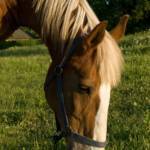Forage for Horses in Australia and New Zealand

In Australia and New Zealand, snow falls only very rarely in areas where horses are kept, so horses can graze year-round. Horses on studs are not typically stabled at night and often have access to pasture all day. Many pastures are poorly managed and suffer from overgrazing by horses and inadequate pasture renovation. Although the country is large, many horse farms are overstocked and pastures suffer accordingly. In temperate areas of Australia, pastures dry off over summer and autumn, which creates a need for supplementary feeding of horses at this time of year. Pastures are usually based on ryegrass and clover.
In Queensland, introduced tropical grasses such as kikuyu, buffel, and seteria are common. These have high oxalate levels that interfere with calcium and phosphorus digestibility and can lead to the development of nutritional secondary hyperparathyroidism. In areas of North Queensland, pasture species such as Morinda spp. or Neptunia amplexicaulis can accumulate selenium and cause selenium toxicity. Australia also has an abundance of poisonous plants with regional distributions, although most of the intensively stocked horse areas are relatively free of poisonous plants.
Climatically the North Island of New Zealand is a warmer area with higher rainfall and is host to the country’s main Thoroughbred breeding studs. The South Island of New Zealand has traditionally been the main breeding area for Standardbreds. Pastures are mainly rye grass and clover on both islands. South Island pastures experience snowfalls from May through to September. Poisonous plants are not a concern in New Zealand horse pastures. Unlike in the South Island, pastures rarely dry off over summer in the North Island.
Australian horses are fed roughage in the form of hay, chaff, pellets and cubes. Lucerne (alfalfa) is the most common hay fed to horses, followed by grass (meadow) hay and oaten hay. Lucerne and grass hay are packed in small bales and the unit of feeding is a biscuit (flake). Unfortunately, wide variation in the density of hay and the width of a biscuit means that the weight of a biscuit can vary from one to three kg. Under those circumstances, nutritional evaluation can be inaccurate unless the weight is actually measured.
The value of grass hay can vary widely according to the composition of the grasses, time of hay making, and other factors. A high clover content will increase the nutrient content of the hay and good-quality clover hay can approach lucerne hay in value. The climatic conditions at the time of hay making are usually favorable, and Australian hay is generally free of dust, molds, and other contaminants. Prices for hay vary substantially according to its type, quality, balance between supply and demand, and transport costs. Oaten hay, fed in sheaves or bales, is less commonly used because production is lower and storage is more difficult.
In times of drought, demand for hay by other livestock can create severe shortages and this has led to the development of several novel fiber sources. Lupin hulls contain 46% fiber and 8.5% crude protein and are used as an affordable, digestible fiber source in pellets and textured feeds.
Australian horses are fed large quantities of chopped hay or chaff. Chaff is made in commercial chaff mills that produce 40-kg bags, or it can be produced on the farm using a small-scale chaff cutter. Racehorses are often fed a mix of oaten or wheaten chaff and lucerne chaff. Immature oats or wheat crops are cut for chaff several weeks before harvest. The timing varies each season but is described as the “early heading stage” or no more than 5 days after flowering. At this stage you can squeeze “milk” out of the head of the grain and the nutrient content of the stalk is higher than at harvest. It is made into sheaves that are stacked for drying in the paddock over several weeks and then cut into 5-cm segments as chaff. Most commercial chaff is steam-cleaned to remove dust and allow easier cutting. Some chaff is rough-cut and contains portions of longer fiber. Good-quality chaff should not contain any formed grain, but chaff often does contain grain.
The principal advantage of chaff is that it can be mixed into the concentrate portion of the feed so that the horse consumes roughage with the concentrate. This can slow down the intake of concentrate and prevent starch overload in the large intestine. Horse owners commonly overestimate the weight of chaff fed because it is very light and may weigh only 300 g/2 liters for oaten or wheaten chaff and 250 g/2 liters for lucerne chaff.
As in Australia, in New Zealand lucerne and oaten chaff are main forms of roughage added to hard feed. Meadow and lucerne hay are fed in similar quantities to stabled performance horses.
The hay-making season is shorter and more difficult in New Zealand, and therefore a great deal of care is needed to ensure hay is cured correctly. There are very limited additional sources of roughage available, unlike Australia where bran and pollard (second-grade flour) are available in fluctuating quantities depending on the demands of the dairy season. Average intakes for performance horses would be 2.5 kg of meadow or lucerne hays with approximately 300 to 400 g of oaten or lucerne chaff. Access to pasture varies from nil to about 2.5 hours if available. Most racing stables have access to pasture and would often cut about 6 kg of pasture for stabled horses.








